Three features of liveable apartments

Poorly designed apartments can seem claustrophobic, regardless of their size.
Well-designed homes, of almost any size can feel light and comfortable if the following elements are considered.
Quality design
Happiness can be defined by architecture. Maximising the feeling of space and comfort is fundamental to good apartment design.
Our research found purchasers were unwilling to compromise poor design for a lower price. The quality of fixtures and finishes is important, but no amount of added joinery can make up for an efficient, highly functional base design.
Acoustic treatment is essential to a functional design. A space feels calm and relaxing if it’s protected from unwanted noise from the street and neighbours.
Spaciousness
Our research found that buyers would pay more for elements that elevate the line of sight and enhance an apartment’s feeling of space, such as fully tiled bathrooms, full height doors and frameless shower screens.
As humans, our feeling of wellbeing is dependent on our comfort and security. Well-planned spaces allow us to relax and shelter from the anxiety and discomfort that plagues our life outside the home, be it at work, commuting or managing a busy social schedule.
The feeling of space is frequently dependent on our line of sight.
High ceilings are a good example: if we have to tilt our neck back in order to see the ceiling, we are assured a space has ample air and light.
Internal amenity is paramount. A feeling of spaciousness can be directly attributed to the amount of visual sky and greenery. An apartment doesn’t have to have the best view, but if it’s designed well, it will maximise natural light and incorporate an internal garden to heighten the feeling of space.
Temperature control
Temperature control is essential to good design, yet is so often victim to value management. Consequently, residents must depend on airconditioning, a costly affair for bills and carbon emissions alike.
Apartments that are poorly constructed with plastic fibre or plasterboard cladding struggle to breathe, loosing heat in winter and roasting in summer. Conversely, exposed concrete has excellent thermal mass, ensuring apartments are cool in summer and warm in winter.
One study quoted by the World Business Council for Sustainable Development found that concrete walls reduce energy requirements for a typical home by 17 per cent. From our research, 82.3 per cent of respondents would consider concrete ceilings in their bedroom.
Laura Phillips is a marketing manager at Neometro and also edits the company’s online publication, Open Journal.
We recommend
We thought you might like
States
Capital Cities
Capital Cities - Rentals
Popular Areas
Allhomes
More
- © 2025, CoStar Group Inc.







